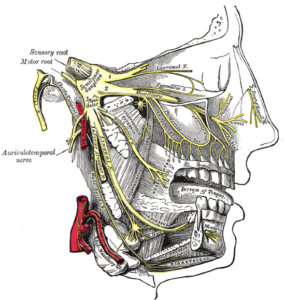What is trigeminal neuralgia?
Trigeminal neuralgia is described as sudden pain in the face. Often described as a “stab” or “electric shock” type pain in the face, chin, teeth or gums.
In most cases, trigeminal neuralgia affects one side of the face, especially the lower part of the face. It can rarely affect both sides of the face, but not at the same time.
Patients with trigeminal neuralgia can have attacks for days, weeks, or months. In some cases they are so severe that they occur more than 100 times a day.
It is possible that the pain subsides or disappears for months or years (periods of remission) and then reappears. However, these periods of remission become shorter and shorter from time to time.
Over time, some patients develop continuous pain, such as a burning sensation and deep pain, associated with the sudden attacks typical of trigeminal pain.
Living with trigeminal neuralgia can be very difficult. The impact on the person’s quality of life is significant, and can lead to problems with excessive weight loss, isolation and depression.
What is the cause of trigeminal neuralgia?
Trigeminal neuralgia is mainly caused by compression of the trigeminal nerve.
The trigeminal nerve is a nerve found in the skull and transmits the sensations of pain and touch of the teeth, mouth and face to the brain.
Compression of the trigeminal nerve is usually caused by the abnormal artery or vein into the skull.
In rare cases, trigeminal neuralgia can be caused by damage to the trigeminal nerve caused by multiple sclerosis or a brain tumors.
Pain attacks are typically triggered by activities such as touching the face, eating, brushing teeth. Sometimes the wind on the face or just the movement of the face and head can be enough to unleash the attacks. Sometimes the pain can occur without an obvious cause.
Who is affected by trigeminal neuralgia?
It is estimated that about 10 in 100,000 people suffer from it.
Women are more affected than men.
The first manifestations of pain usually occur between the ages of 50 and 60.
Trigeminal neuralgia is rare in patients under the age of 50.
How to treat trigeminal neuralgia?
Trigeminal neuralgia is a long-term condition, and the periods of remission become shorter and shorter.
The first recommended treatment for trigeminal neuralgia is medical treatment. An anticonvulsant such as carbamazepine (a drug also used to treat epilepsy) is the treatment of choice. To have an effect, carbamazepine must be taken gradually increasing the dose over the course of days or weeks for its concentration in the blood to be adequate.
Carbamazepine helps to reduce electrical impulses in the nerves and reduce pain transmission.
If carbamazepine is ineffective or the side effects are too obvious, there are several procedures that may be indicated, including surgery.
The most effective surgical procedure over time is “microvascular decompression”.
The surgery involves an incision behind the ear, the opening of a bony operculum and access to the inside of the skull where the trigeminal nerve is located.
The artery or vein that compresses it and causes the pain is identified under the operating microscope or endoscope and removed by microsurgical techniques from the trigeminal nerve.
In this way the pulsation of the artery is no longer transmitted to the nerve and the pain disappears.
The surgical procedure of “microvascular decompression” presents low potential risks of stroke, hearing loss and other risks present in any intracranial procedure. To avoid those complications we perform the intervention with advanced microsurgical and endoscopic techniques and intraoperative monitoring techniques to evaluate the patient’s functions in real time throughout the whole surgery.

